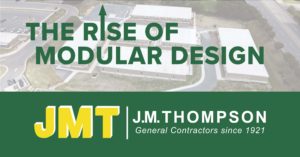Modular and pre-fabricated commercial construction is experiencing a rise in popularity that many are predicting will keep trending up well into 2025. This type of construction is redefining the process of construction and providing greener and safer opportunities for the industry. If this trend continues, this market is predicted to grow up to $110 billion by 2025 which means that modular design should be taken seriously by all construction companies. Those who are experienced and familiar with this type of construction will show a level of diversity within their portfolio.
Misconceptions of Modular Design
Modular and pre-fabricated design has some stigma or misconceptions attached to it. Many have an unclear definition on what modular design is. Some may think of modular design as a double-wide home that can be transported down a highway and placed on a plot of land. However, that only scratches the surface of pre-fabricated buildings.
Modular design and pre-fabricated construction is when parts of buildings are constructed off-site and then transported to the site upon completion. The larger pieces of the building are put together like massive jigsaw pieces on the jobsite. In the 1950s, the only buildings that fit this description were mobile homes. Now, modular design has evolved and broadened its original narrow market base. Modular design encompasses massive high rises stories tall which are permanently secured on a site foundation, as well as additional educational facilities and functional office spaces. The ingenuity of this type of design is the fact that the buildings can be constructed in a safe, indoor environment that mitigates weather and other delays. The buildings can also be constructed in tandem with site work and foundations.
Benefits of Modular Design
Modular design has expanded across multiple market sectors including office buildings, hospitality, educational facilities, and multi-family units. This type of design is not only versatile across multiple sectors, it is also a greener way to build, provides a faster construction time with less delays, and is safer for those who are constructing the project.
This type of design produces less material waste and offers a greater opportunity to reuse materials. The Modular Building Institute conducted peer-reviewed research that discovered that the modular construction process sent 75% less wood and drywall waste to the landfill and reduced CO2 emissions by 43%. Since construction occurs off-site and indoors, these facilities have less pollution from heavy machinery and provide filtered air for workers.
Another benefit of modular design is providing a safer work environment to subcontractors and general contractors assigned to the project. Because most of construction happens in an indoor facility, workers are safer, and there is a more consistent work environment than on a typical construction site. There are less obstacles and safety hazards which mitigates injuries, incidents, and falls.
Along with being greener and safer, modular design is faster than most conventional designs. According to the Journal of Civil Engineering & Management, 45% of construction projects are delayed due to weather conditions. Though many of these delays occur during the site work and foundation laying, modular design helps mitigate some of these delays. Since some construction can occur indoors, a general contractor or construction manager does not need to factor in weather delays for constructing pre-fabricated components. Contractors can prep the site and complete all the grading, foundations, and concrete before the buildings arrive on-site. Each aspect of the project can be built simultaneously without interfering with each other.
For these reason and many others, modular design offers another option for the construction industry. It provides a variety of benefits including a faster, safer way to produce functional buildings.
Modular Design in North Carolina
The Modular Building Institute has noticed a rise in modular construction in North Carolina and the southeast region in the past few years. The market sectors within this region are expanding to include office buildings and educational facilities.
Within the Triangle, permanent modular design multi-family units are trending and being heavily marketed due to the large development and population boom Raleigh is experiencing. PCX Corp., a pre-fabricated power distribution systems builder, recently moved to North Carolina believing that the Triangle is a rising leader in this innovative way to build. General contractors in NC should be familiar with this type of construction as it will continue to penetrate more market sectors in the area.
J.M. Thompson’s Experience with Modular Construction
J.M. Thompson, general contractors in NC, is familiar with modular design and has gained the knowledge and experience that this type of project entails. Our company completed the Asheboro High School Modular Campus in anticipation for the larger renovations that would take place inside the established school building. The five pre-fabricated buildings were built off-site while the site work was being completed at the same time. Then, the buildings were transported to the jobsite and puzzle-pieced together. By creating a modular campus, J.M. Thompson provided students and staff with a functional learning environment that is free from construction noise or interference.

About J.M. Thompson
A family-owned and operated company, J.M. Thompson brings together vast construction knowledge to each project they take on. The team is comprised of experienced professionals in the industry, as the company is only as good as its employees. The staff assumes full responsibility for the successful projects found in the company portfolio.
Any commercial construction project needs the best pre-construction planning and services for successful completion. The best company will ask for owner feedback on the budget, the timeline, and all aspects of the construction planning. Pre-construction service professionals from our company will ensure that every detail of your construction project is addressed.

